
Concept explainers
(a)
Interpretation:
Lewis structure of periodate ion
Concept Introduction:
Lewis structure represents covalent bonds and describes valence electrons configuration of atoms. The covalent bonds are depicted by lines and unshared electron pairs by pairs of dots. The sequence to write Lewis structure of some molecule is given as follows:
- The central atom is identified and various other atoms are arranged around it. This central atom so chosen is often the least electronegative.
- Total valence electrons are estimated for each atom.
- A single bond is first placed between each atom pair.
- The electrons left can be allocated as unshared electron pairs or as multiple bonds around
symbol of element to satisfy the octet (or duplet) for each atom. - Add charge on overall structure in case of polyatomic cation or anion.
(a)
Explanation of Solution
The molecule
The symbol for oxygen is
The symbol for iodine is
One negative charge on molecule is added up as one valence electron in total count.
Thus total valence electrons are sum of the valence electrons for each atom in
The skeleton structure in
To complete the valence electrons of iodine, it forms double bond with three oxygen atoms.
Hence, the Lewis structure for
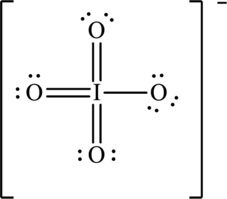
To complete the octet of iodine atom the negative charge is delocalized on each oxygen atom and since there are four oxygen atoms, therefore, four resonance structures will be formed and possible resonance structures are as follows:

(b)
Interpretation:
Lewis structure of hydrogen phosphate ion
Concept Introduction:
Refer to part (a).
(b)
Explanation of Solution
Hydrogen phosphate ion
The symbol for oxygen is
The symbol for hydrogen is
The symbol for phosphorus is
Two negative charges on molecule are added up as one valence electron in total count.
Thus total valence electrons are sum of the valence electrons for each atom in
The skeleton structure in
To complete the valence electrons of phosphorous, it forms double bond with one oxygen atom.
Hence, 20 electrons are allocated as 10 lone pairs on remaining oxygen atoms to complete their octet. The Lewis structure is as follows:

The negative charge is delocalized on three oxygen atoms and therefore three resonance structures will be formed and possible resonance structures are as follows:
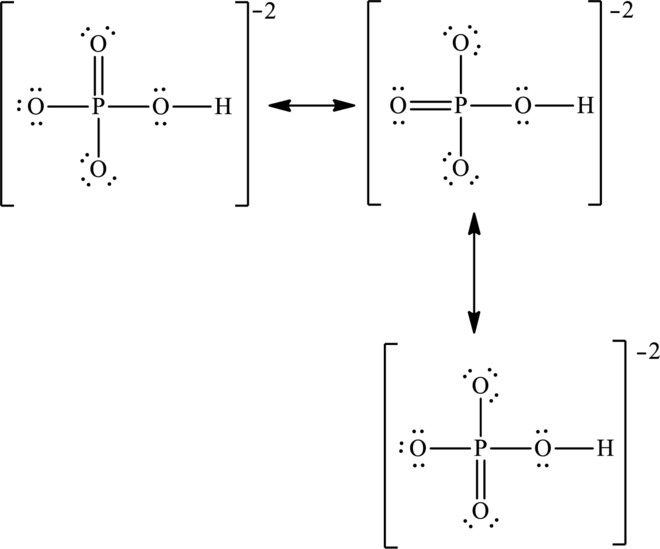
(c)
Interpretation:
Lewis structure of chloric acid
Concept Introduction:
Refer to part (a).
(c)
Explanation of Solution
Chloric acid
The symbol for oxygen is
The symbol for hydrogen is
The symbol for chlorine is
Thus total valence electrons are sum of the valence electrons for each atom in
The skeleton structure in
To complete the valence electrons of chlorine, it forms double bond with two oxygen atoms.
Hence, 14 electrons are allocated as 6 lone pairs on remaining oxygen atoms and 1 lone pair on chlorine to complete their respective octet. The Lewis structure is as follows:
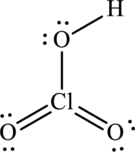
The lone pair on oxygen atom that is attached to chlorine participates in resonance with that and produces

(d)
Interpretation:
Lewis structure of arsenate ion
Concept Introduction:
Refer to part (a).
(d)
Explanation of Solution
Arsenate ion
The symbol for oxygen is
The symbol for arsenic is
The symbol for chlorine is
Three negative charges on molecule is added up as three valence electrons in total count. Thus total valence electrons are sum of the valence electrons for each atom in arsenate ion
The skeleton structure in arsenate ion
To complete the valence electrons of arsenic, it forms double bond with one oxygen atom.
Hence, 22 electrons are allocated as 11 lone pairs on remaining oxygen atoms to complete their octet. The Lewis structure is as follows:
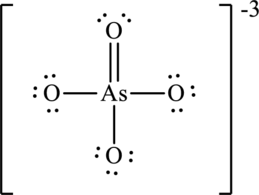
The negative charge is delocalized on each oxygen atom and since there are four oxygen atoms, therefore, four resonance structures will be formed and possible resonance structures are as,
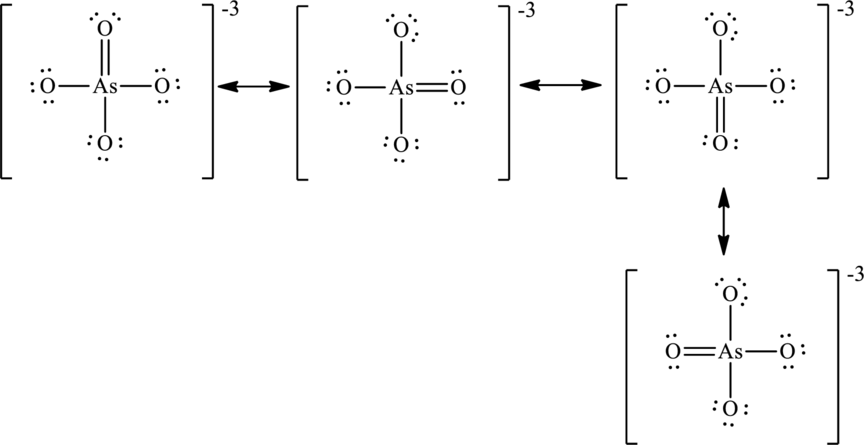
Want to see more full solutions like this?
Chapter 2 Solutions
ACHIEVE/CHEMICAL PRINCIPLES ACCESS 1TERM
- 4. True or false: This skeletal structure represents a saturated fatty acid. Ini to 0 fale) me OH faistong starrow_forwardBy malonic or acetylacetic synthesis, synthesize 5-Methyl-2-hexanone (with the formulas of the compounds).arrow_forwardQUESTION: Answer Question 5: 'Calculating standard error of regression' by filling in all the empty green boxes *The values are all provided in the first photo attached*arrow_forward
- Draw the formula for 3-chlorobenzoic acetic anhydride.arrow_forwardBy malonic or acetylacetic synthesis, synthesize 2-methylbutanoic acid (indicate the formulas of the compounds).arrow_forwardObtain 2-methylbutanoic acid by malonic or acetylacetic synthesis (indicate the formulas of the compounds involved).arrow_forward
- EFFICIENTS SAMPLE READINGS CONCENTRATIONS Pigiadient) TOMATO SAUCE (REGULAR) TOMATO (REDUCED SALT) TOMATO SAUCE (REGULAR) TOMATO (REDUCED SALT) 58 6.274 3.898 301.7 151.2 14150 5.277 3.865 348.9 254.8 B 5.136 3.639 193.7 85.9 605 4.655 3.041 308.6 199.6 05 5.135 3.664 339.5 241.4 0139 4.676 3.662 160.6 87.6 90148 5.086 3.677 337.7 242.5 0092 6.348 3.775 464.7 186.4 PART3 5.081 3.908 223.5 155.8 5.558 3.861 370.5 257.1 4.922 3.66 326.6 242.9 4.752 3.641 327.5 253.3 50 5.018 3.815 336.1 256.0 84 4.959 3.605 317.9 216.6 38 4.96 3.652 203.8 108.7 $3 5.052 3.664 329.8 239.0 17 5.043 3.767 221.9 149.7 052 5.058 3.614 331.7 236.4 5.051 4.005 211.7 152.1 62 5.047 3.637 309.6 222.7 5.298 3.977 223.4 148.7 5.38 4.24 353.7 278.2 5 5.033 4.044 334.6 268.7 995 4.706 3.621 305.6 234.4 04 4.816 3.728 340.0 262.7 16 4.828 4.496 304.3 283.2 0.011 4.993 3.865 244.7 143.6 AVERAGE STDEV COUNT 95% CI Confidence Interval (mmol/L) [Na+] (mg/100 mL) 95% Na+ Confidence Interval (mg/100 mL)arrow_forwardIf we have two compounds: acetone (CH₃COCH₃) and acetic acid (CH₃COOH), applying heat to them produces an aldol condensation of the two compounds. If this is correct, draw the formula for the final product.arrow_forwardIf we have two compounds: acetone (CH3COCH3) and acetic acid (CH3COOH); if we apply heat (A), what product(s) are obtained?arrow_forward
- QUESTION: Fill out the answers to the empty green boxes attached in the image. *Ensure you all incorporate all 27 values (per column)*arrow_forwardYou need to make a buffer by dissolving benzoic acid and sodium benzoate in water. What is the mass of benzoic acid that you would weigh out, in mg, to create 50 mL of a buffer at pH = 4.7 that will change pH no more than 0.10 units with the addition of 0.001 moles of acid or base? Enter just the answer without the units (mg) - just the number will do!arrow_forwardDraw the formula for 3-isopropylcyclopentane-1-carbonyl chloride.arrow_forward
 Chemistry: The Molecular ScienceChemistryISBN:9781285199047Author:John W. Moore, Conrad L. StanitskiPublisher:Cengage Learning
Chemistry: The Molecular ScienceChemistryISBN:9781285199047Author:John W. Moore, Conrad L. StanitskiPublisher:Cengage Learning

